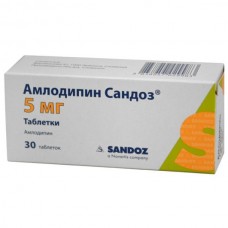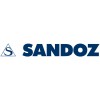Expiration date: 11/2026
Composition and form of issue:
Tablets. 1 tablet contains active substance:
amlodipine bezilate 6, 934 mg
13, 868 mg
(equivalent to 5 or 10 mg amlodipine, respectively)
excipients: lactose anhydrous MCC corn starch (dry) talc silicon dioxide colloidal anhydrous magnesium stearate
Tablets. 1 tablet contains active substance:
amlodipine bezilate 6, 934 mg
13, 868 mg
(equivalent to 5 or 10 mg amlodipine, respectively)
excipients: lactose anhydrous MCC corn starch (dry) talc silicon dioxide colloidal anhydrous magnesium stearate
in blister packs of 10 tablets, cartons of 3 blister.
Description of dosage form:
Round, flat white or white tablets with a yellowish tinge of color, with a risk on one side and a chamfer.
Characteristic:
A derivative of dihydropyridine — CCB II generation.
Pharmacokinetics:
After oral amlodipine is slowly absorbed from the gastrointestinal tract. The average absolute bioavailability of 64%, Cmax in serum was observed after 6-9 h. the Concentration of stable equilibrium is achieved after 7 days of therapy. Food does not affect the absorption of amlodipine. The average Vd is 21 l / kg body weight, indicating that most of the drug is in the tissues, and relatively less — in the blood. Most of the drug in the blood (95%) is bound to plasma proteins. Amlodipine undergoes slow but extensive metabolism (90%) in the liver with the formation of inactive metabolites, has the effect of the first passage through the liver. Metabolites have no significant pharmacological activity. After a single oral administration of T1/2 varies from 31 up to 48 h, when re-assigning T1/2 is approximately 45 h. About 60% of an oral dose is excreted by the kidneys mainly as metabolites, 10% unchanged, and 20-25 % in the feces, and breast milk. The total clearance of amlodipine is 0, 116 ml/s/kg (7 ml/min/kg 0, 42 l/h / kg). In elderly patients (over 65 years), the excretion of amlodipine is slowed (T1 / 2 — 65 h) compared to young patients, but this difference is not of clinical significance.
In patients with hepatic insufficiency, lengthening T1/2 is assumed, and with long — term administration of the drug in the body will be higher (T1/2-up to 60 h).
Renal failure does not significantly affect the kinetics of amlodipine. The drug penetrates the BBB. When hemodialysis is not removed.
Description of pharmacological action:
It has antianginal and hypotensive effect. Communicating with digidropiridinovmi receptors, does calzieve channels, lowers transmembranny transition of calcium ions into the cell (more in gladkomyshechne cells receptacles, than cardiomiotita). Antianginal effect is due to the expansion of the coronary and peripheral arteries and arterioles: with angina reduces the severity of myocardial ischemia expanding peripheral arterioles, reduces OPSS, reduces preload on the heart, reduces myocardial oxygen demand. Expanding the main coronary arteries and arterioles in unchanged and ischemic areas of the myocardium, increases the flow of oxygen to the myocardium (especially in vasospastic angina) prevents the development of coronary artery constriction (incl.Smoking). In patients with angina pectoris, a single daily dose increases the time of physical activity, slows down the development of angina pectoris and ischemic depression of the ST segment, reduces the frequency of angina attacks and the consumption of nitroglycerin.
It has a long dose-dependent hypotensive effect. Hypotensive effect due to direct vasodilating effect on the smooth muscles of blood vessels. In hypertension, a single dose provides a clinically significant decrease in blood PRESSURE for 24 hours (in the patient's lying and standing). Does not cause the sharp decline in AD, reduced tolerance to physical load and ejection fraction of the left ventricle. Reduces the degree of myocardial hypertrophy of the left ventricle, exerts anti-atherosclerotic and cardioprotective action in coronary heart disease. It does not affect the contractility and conductivity of the myocardium, does not cause a reflex increase in heart rate, inhibits platelet aggregation, increases glomerular filtration rate, has a weak natriuretic effect. In diabetic nephropathy does not increase the severity of microalbuminuria. It has no adverse effect on the metabolism and blood plasma lipids. The time of the effect-2-4 hours, the duration of the effect 24 hours.
Indications:
- arterial hypertension
- IHD: stable angina, vasospastic angina (Prinzmetal's angina).
Contraindications:
- increased sensitivity to amlodipine and other dihydropyridine derivatives
- severe hypotension
- collapse, cardiogenic shock
- unstable angina (except prinzmetals angina)
- the age of 18 years (efficacy and safety have not been established)
- hereditary lactose intolerance, galactosemia (the drug includes lactose).
With caution:
- liver failure
- mild or moderate hypotension
- acute myocardial infarction and during the first month after it
- stenosis of the aortic mouth
- chronic heart failure in the stage of decompensation
- sunus node weakness syndrome
- hypertrophic obstructive cardiomyopathy
- old age.
Use during pregnancy and breast-feeding:
Safety during pregnancy and lactation is not established, so the appointment of the drug is possible only if the expected benefit to the mother exceeds the potential risk to the fetus.
When prescribing the drug during lactation should decide on the termination of breastfeeding.
Side effect:
Classification of side effects when using the drug on the frequency of occurrence: often-more than 1%, rarely-from 0, 1% to 1%, very rarely-less than 0, 01%.
Central and peripheral nervous system: often-headache, dizziness, fatigue, drowsiness, lability of mood rarely — asthenia, fainting, convulsions, peripheral neuropathy, increased sweating, insomnia, depression very rarely — apathy, ataxia, migraine.
Cardiovascular system: often-heartbeat, shortness of breath, blood flushes to the face, peripheral edema rarely — chest pain, excessive blood PRESSURE reduction, orthostatic hypotension very rarely — heart rhythm disorders (ventricular tachycardia, atrial fibrillation), myocardial infarction, heart failure.
The digestive system: often — nausea, dry mouth, abdominal pain, rarely — indigestion, constipation, diarrhoea, gingival hyperplasia, pancreatitis, very rarely — gastritis, jaundice, increase in liver transaminases.
Urogenital system: rare — pollakiuria, sexual dysfunction.
Musculoskeletal system: often-back pain rarely-myalgia, arthralgia, muscle cramps.
Allergic reactions: rarely-itchy skin, rash very rarely-erythema multiforme, angioedema.
Other: rarely-visual impairment, dyspnea, alopecia, gynecomastia very rarely — hyperglycemia, thrombocytopenia.
Drug interaction:
Inhibitors of microsomal oxidation can increase the concentration of amlodipine in plasma, increasing the risk of side effects, and inducers of microsomal liver enzymes — reduce.
Unlike other bmcc, there is no clinically significant interaction with NSAIDs, especially indomethacin.
Thiazide and loop diuretics, beta-blockers, verapamil, ACE inhibitors and nitrates enhance antianginal or hypotensive effects.
It has no effect on the pharmacokinetic parameters of digoxin and warfarin.
Cimetidine does not affect the pharmacokinetics of amlodipine.
Calcium supplementation may reduce the effect of bmcc.
Antiviral agents (ritonavir) increase plasma concentrations of bmcc.
Neuroleptics and isoflurane — enhancing the hypotensive effect of dihydropyridine derivatives.
Dosage and administration:
Inside, regardless of the meal.
For the treatment of hypertension and prevention of angina attacks tension and vasospastic angina the initial daily dose of amlodipine Sandoz is 5 mg in one dose. If necessary, the dose can be increased to a maximum — 10 mg/day, once.
Patients with low body weight or low growth, as well as severe liver failure may require lower doses.
No dose change is required while administered with thiazide diuretics, beta-blockers and ACE inhibitors.
Patients with renal insufficiency and elderly patients do not need dose adjustment.
Overdose:
Overdose of amlodipine can lead to excessive peripheral vasodilation with a clinically pronounced decrease in blood PRESSURE and the possible development of reflex tachycardia.
Treatment: the appointment of activated carbon (in the first 2 hours after overdose), gastric lavage, elevated position of the limbs, control of the functions of the CCC and respiratory system, the volume of circulating blood and diuresis, active maintenance of the functions of CCC may prescribe vasoconstrictive drugs to restore vascular tone and increase blood PRESSURE to eliminate the effects of calcium channel blockade — b/in the introduction of calcium gluconate. Hemodialysis is ineffective.
Special instruction:
It is optimal to use the drug every day at the same time.
Despite the absence of bmkk of the syndrome, before terminating treatment recommended gradually reducing the dose.
Amlodipine Sandoz may be administered in combination with thiazide diuretics, alpha - and beta-blockers, ACE inhibitors, nitrates of prolonged action, sublingual nitroglycerin, NSAIDs, antibiotics, oral hypoglycemic agents.
Amlodipine Sandoz has no adverse effect on the metabolism and plasma lipids, so it can be used in patients with asthma, diabetes and gout.
Effect on the ability to concentrate: the use of amlodipine does not affect the ability to drive or other technical means, however, due to the possible excessive reduction of blood PRESSURE, slowing the reaction rate due to the development of dizziness, headache, fatigue, etc.side effects, should be carefully treated to the individual action of the drug at the beginning of treatment and when changing the dosage regimen.



